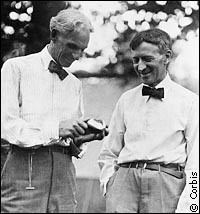Start date May 2000 | ||
 | ||
Firestone ford tire controversy a claymation exploration
The Firestone and Ford tire controversy was a period of unusually high tire failures on the Ford Explorer and related vehicles equipped with Firestone tires.
Contents
- Firestone ford tire controversy a claymation exploration
- Firestone tires
- Problem detection
- Possible causes
- Recall
- End and rebirth of FordFirestone relations
- References
The Ford Motor Company had a historically strong relationship with Firestone since its inception, with Henry Ford and Harvey Samuel Firestone being personal friends and even the two families being linked in marriage with their respective grandchildren, William Clay Ford, Sr. and Martha Parke Firestone being married in 1947. United States-based Firestone became a subsidiary of Japanese tire manufacturer Bridgestone in 1988.
Firestone tires
Problem detection
In May 2000, the U.S. National Highway Traffic Safety Administration (NHTSA) contacted Ford and Firestone about the high incidence of tire failure on Ford Explorers, Mercury Mountaineers, and Mazda Navajos fitted with Firestone tires. Ford investigated and found that several models of 15-inch Firestone tires (ATX, ATX II, and Wilderness AT) had very high failure rates, especially those made at Firestone's Decatur, Illinois plant. This was one of the leading factors to the closing of the Decatur plant.
Joan Claybrook, who was the president of the public advocacy group Public Citizen and previously an Administrator of the NHTSA, stated before the Transportation Subcommittee United States Senate Committee on Appropriations on September 6, 2000, that, "there was a documented coverup by Ford and Firestone of the 500 defect". This refers to the 1970s debacle that had already tarnished Firestone's reputation. Also Clarence Ditlow; Executive Director for the Centre for Auto Safety in his statement before the Senate Committee on Commerce, Science and Transportation in Washington D.C., September 20, 2000 stated "Emerging Information shows that both Ford and Firestone had early knowledge of tread separation in Firestone Tires fitted to Ford Explorer vehicles but at no point informed the NHTSA of their findings".
Possible causes
The Ford Explorer was first offered for sale in March 1990. Ford internal documents show the company engineers recommended changes to the vehicle design after it rolled over in company tests prior to introduction, but other than a few minor changes, the suspension and track width were not changed. Instead, Ford, which sets the specifications for the manufacture of its tires, decided to remove air from the tires, lowering the recommended pressure to 26 psi. Low air pressure leads to increased heat; heat can damage the tire.
The failures all involved tread separation—the tread peeling off followed often by tire disintegration. Tread separation, due to the interaction of steel and rubber tire elements, has been a challenge in radial tire design since their development by Michelin in 1946. In 1968, Michelin proposed a nylon cap over the steel elements to counteract this, and Firestone adopted this nylon cap design in 2000, following investigation by the United States Congress.
If tread separation happened, and the vehicle was running at speed, there was a possibility of the sport utility vehicle (SUV), with its high center of gravity between 68 and 74 cm, of rolling over. Over 240 deaths resulted from these failures. Not every single death occurred in the Ford Explorer/Firestone tire combination. It is estimated that 3,000 catastrophic injuries also resulted from this issue.
Some outside observers have speculated about the blame worthiness of both parties; Firestone's tires being prone to tread separation and failure, and the SUVs being especially prone to rolling over if a tire fails at speed compared to other vehicles. A subsequent NHTSA investigation of real world accident data showed that the SUVs in question were no more likely to roll over than any other SUV, after a tread separation.
Recall
A product recall was announced, allowing Explorer owners (and owners of its stablemates) to change the affected tires for others. Many of the recalled tires had been manufactured during a period of strike at Firestone. A large number of lawsuits have been filed against both Ford and Firestone, some unsuccessful, some settled out of court, and a few successful. Lawyers for the plaintiffs have argued that both Ford and Firestone knew of the dangers but did nothing, and that specifically Ford knew that the Explorer was highly prone to rollovers. Ford denies these allegations.
Firestone ultimately recalled millions of tires including 2.8 million Firestone Wilderness AT tires. According to Firestone's last filing with the National Highway Transportation Administration, only 90,259 of those tires were confirmed as removed from service. In November 2013, two recalled Wilderness AT tires were found in Atlanta, Georgia. One of the tires was offered for sale as new at a used tire retail shop.
Following the recall, lawsuits were filed throughout the country. It was estimated that there had been over 250 deaths and 3,000 serious injuries. Because of the number of lawsuits the plaintiffs’ attorneys became concerned that the tire company would not have enough money to pay all of the claims and began looking for other sources of revenue. A principal target were the large tire sellers and services such as Sears, Roebuck and Co.
End and rebirth of Ford/Firestone relations
John T. Lampe (Chairman & CEO of Bridgestone/Firestone) announced in a 2001 letter to Jacques Nasser (Ford Motor Company chief executive) that Bridgestone/Firestone would no longer enter into new contracts with Ford Motor Company, effectively ending a 100-year supply relationship.
